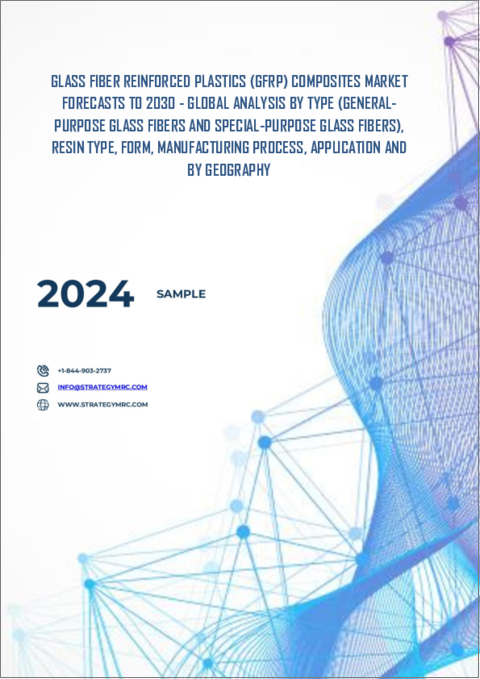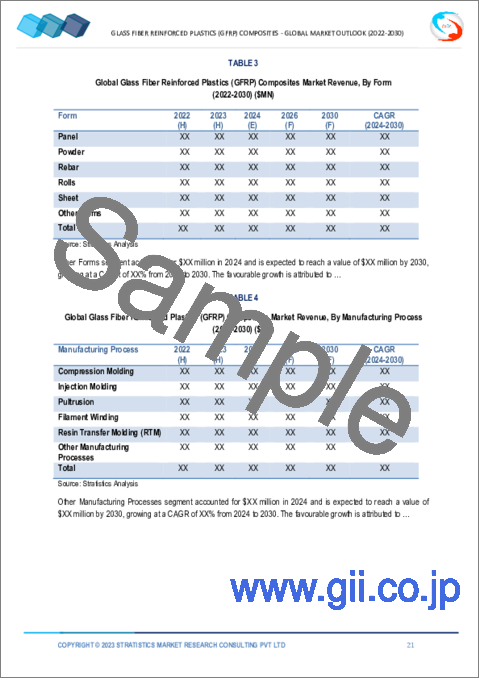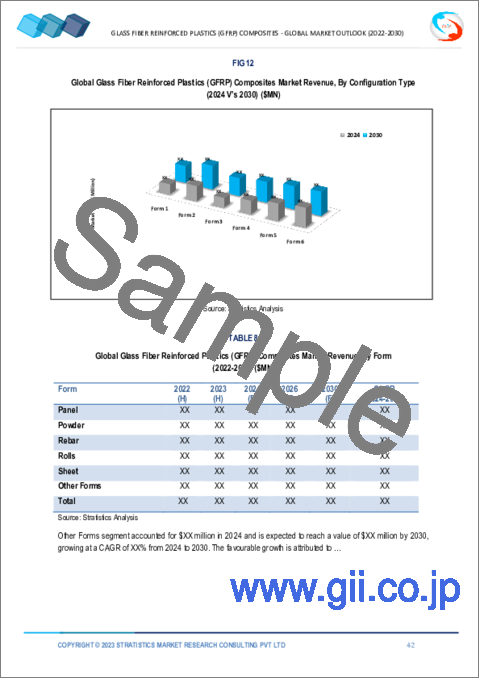|
|
市場調査レポート
商品コード
1503375
ガラス繊維強化プラスチック(GFRP)複合材料市場の2030年までの予測: タイプ別、樹脂タイプ別、形状別、製造プロセス、用途、地域別の世界分析Glass Fiber Reinforced Plastics (GFRP) Composites Market Forecasts to 2030 - Global Analysis By Type (General-Purpose Glass Fibers and Special-Purpose Glass Fibers), Resin Type, Form, Manufacturing Process, Application and By Geography |
||||||
カスタマイズ可能
|
|||||||
| ガラス繊維強化プラスチック(GFRP)複合材料市場の2030年までの予測: タイプ別、樹脂タイプ別、形状別、製造プロセス、用途、地域別の世界分析 |
|
出版日: 2024年06月06日
発行: Stratistics Market Research Consulting
ページ情報: 英文 200+ Pages
納期: 2~3営業日
|
全表示
- 概要
- 図表
- 目次
Stratistics MRCによると、ガラス繊維強化プラスチック(GFRP)複合材料の世界市場は、2024年に200億1,000万米ドルを占め、予測期間中にCAGR 8.5%で成長し、2030年には356億7,000万米ドルに達すると予想されています。
ガラス繊維強化プラスチック(GFRP)複合材料は、ガラス繊維で強化されたポリマーマトリクスで構成される材料です。ガラス繊維は一般的にガラスフィラメントのストランドから作られ、複合材料に強度、剛性、耐久性を与えます。GFRP複合材料は、その高い強度対重量比、耐食性、電気絶縁特性で知られています。GFRP複合材料は、特定の性能特性を高めるように設計されており、汎用性の高いソリューションとなっています。
サウジアラビア政府は、経済変革計画「ビジョン2030」に従い、数多くのインフラプロジェクトを開始しました。これらのプロジェクトは主に、電力、水、炭化水素、建設、道路、鉄道、港湾、空港の各分野に関連するプロジェクトを対象としています。
電気自動車における軽量材料への需要の高まり
GFRP複合材料は高い強度対重量比を持ち、電気自動車全体の軽量化に貢献します。この軽量化は、エネルギー効率を高め、航続距離を延ばし、電気自動車普及の重要な要因となっています。さらに、GFRP複合材料は耐腐食性と設計の柔軟性を提供し、厳しい自動車基準を満たします。自動車メーカーが持続可能性と性能を重視し続ける中、GFRP複合材料のEVへの使用は拡大し、自動車分野での市場拡大を牽引しています。
リサイクルの課題
GFRP複合材料におけるリサイクルの課題は、ガラス繊維とポリマーマトリックスを組み合わせるという複雑な性質に起因しています。リサイクルのためにこれらの材料を分離するのは難しく、コストもかかります。この制限は、廃棄コストの増加、環境意識の高い産業における材料の魅力の低下、リサイクル規制への準拠の複雑化など、市場の妨げとなっています。
世界のインフラプロジェクトへの投資拡大
GFRP複合材料は、高強度、耐食性、軽量という特性を備えており、橋梁、トンネル、建築物などのインフラ用途に理想的です。これらの材料は、耐久性と持続可能性を高めながら、建設時間とコストを削減します。政府と民間部門は、厳しい規制基準を満たし、長期的な経済的利益を達成するために、GFRP複合材料を選択するようになってきており、それによって世界市場の著しい成長を牽引しています。
加工の複雑さ
GFRP複合材料の複雑な加工には、正確な繊維配列、樹脂注入、硬化パラメーターなどが含まれ、特殊な設備と熟練した労働力を必要とします。これらの複雑さは生産コストと時間を増加させ、自動車や消費財のようなコストに敏感な市場での大量採用を制限します。さらに、工程の複雑さによる品質のばらつきは、信頼性と性能の一貫性に影響を与える可能性があり、信頼性が高く効率的な製造ソリューションを求める産業界にとって、市場の成長を妨げる要因となっています。
COVID-19の影響
COVID-19の大流行は、ガラス繊維強化プラスチック(GFRP)複合材料市場に大きな影響を与えました。サプライチェーンの混乱、産業活動の低下、建設プロジェクトの減少が需要を停滞させました。しかし、耐腐食性や軽量性など、ヘルスケアや基幹インフラで重宝される材料の特性により、市場は回復力を見せた。産業が回復し、持続可能性を優先するようになるにつれて、GFRP複合材料は再び成長する見込みで回復すると予想されます。
予測期間中、ロール部門が最大となる見込み
ロール部門は有利な成長を遂げると推定されます。ロール状のガラス繊維強化プラスチック(GFRP)複合材料は、高い強度対重量比と耐久性で知られる万能材料です。これらのロールは、建築、自動車、航空宇宙を含む様々な産業で補強目的で使用されています。耐腐食性や耐環境性にも優れているため、長寿命で信頼性の高い性能を必要とする用途に最適です。取り扱いと設置が容易なGFRPロールは、構造の完全性と寿命を高めます。
予測期間中、建設分野が最も高いCAGRを持つと予想される
建設分野は、予測期間中に最も速いCAGRの成長が見込まれます。GFRP複合材料は、その高強度、軽量、耐腐食性により、建設分野で広く使用されています。GFRP複合材料は、コンクリート構造物、橋梁、建物の補強に使用され、耐久性とメンテナンスコストの削減を実現します。GFRP複合材料は、構造性能を高め、設計の柔軟性を提供し、建設プロジェクトの寿命を向上させます。また、GFRPは非導電性であるため、電磁波の透過性が求められる環境での使用にも適しています。
最大のシェアを占める地域
アジア太平洋地域は、急速な工業化とインフラ整備により、ガラス繊維強化プラスチック(GFRP)複合材料市場の主要拠点となっています。中国、日本、インド、韓国などの国々が主要な貢献国であり、自動車、建設、航空宇宙、電気産業などでGFRPコンポジットを活用しています。この地域は、都市化の進展、インフラへの政府投資、軽量で耐久性のある材料への需要の高まりなどの恩恵を受けています。全体として、材料技術の革新により、アジア太平洋地域は世界のGFRP複合材料産業において極めて重要な地域となっています。
CAGRが最も高い地域:
北米では、ガラス繊維強化プラスチック(GFRP)複合材料市場は、自動車、航空宇宙、海洋、建設などの産業における多様な用途に牽引され、堅調に推移しています。この地域は、高度な製造能力、強力な研究開発投資、軽量で持続可能な材料を支持する厳格な規制基準の恩恵を受けています。全体として、北米はGFRPコンポジットの重要な市場であり、革新的な用途で成長する機会があります。
無料カスタマイズサービス
本レポートをご購読のお客様には、以下の無料カスタマイズオプションのいずれかをご利用いただけます:
- 企業プロファイル
- 追加市場プレーヤーの包括的プロファイリング(3社まで)
- 主要企業のSWOT分析(3社まで)
- 地域セグメンテーション
- 顧客の関心に応じた主要国の市場推計・予測・CAGR(注:フィージビリティチェックによる)
- 競合ベンチマーキング
- 製品ポートフォリオ、地理的プレゼンス、戦略的提携に基づく主要企業のベンチマーキング
目次
第1章 エグゼクティブサマリー
第2章 序文
- 概要
- ステークホルダー
- 調査範囲
- 調査手法
- データマイニング
- データ分析
- データ検証
- 調査アプローチ
- 調査情報源
- 1次調査情報源
- 2次調査情報源
- 前提条件
第3章 市場動向分析
- 促進要因
- 抑制要因
- 機会
- 脅威
- 用途分析
- 新興市場
- COVID-19の影響
第4章 ポーターのファイブフォース分析
- 供給企業の交渉力
- 買い手の交渉力
- 代替品の脅威
- 新規参入業者の脅威
- 競争企業間の敵対関係
第5章 世界のガラス繊維強化プラスチック(GFRP)複合材料市場:タイプ別
- 汎用ガラス繊維
- 特殊ガラス繊維
第6章 世界のガラス繊維強化プラスチック(GFRP)複合材料市場:樹脂タイプ別
- ポリエステル樹脂
- エポキシ樹脂
- ビニルエステル樹脂
- ポリウレタン樹脂
- フェノール樹脂
- アクリル樹脂
- シアネートエステル樹脂
- その他の樹脂タイプ
第7章 世界のガラス繊維強化プラスチック(GFRP)複合材料市場:形状別
- パネル
- 粉末
- 鉄筋
- ロール
- シート
- その他の形状
第8章 世界のガラス繊維強化プラスチック(GFRP)複合材料市場:製造プロセス別
- 圧縮成形
- 射出成形
- プルトルージョン
- フィラメントワインディング
- 樹脂トランスファー成形(RTM)
- その他の製造プロセス
第9章 世界のガラス繊維強化プラスチック(GFRP)複合材料市場:用途別
- 自動車
- 航空宇宙
- 建設
- 風エネルギー
- 海洋
- 電気・電子
- スポーツ・レジャー
- その他の用途
第10章 世界のガラス繊維強化プラスチック(GFRP)複合材料市場:地域別
- 北米
- 米国
- カナダ
- メキシコ
- 欧州
- ドイツ
- 英国
- イタリア
- フランス
- スペイン
- その他欧州
- アジア太平洋地域
- 日本
- 中国
- インド
- オーストラリア
- ニュージーランド
- 韓国
- その他アジア太平洋地域
- 南米
- アルゼンチン
- ブラジル
- チリ
- その他南米
- 中東・アフリカ
- サウジアラビア
- アラブ首長国連邦
- カタール
- 南アフリカ
- その他中東とアフリカ
第11章 主な発展
- 契約、パートナーシップ、コラボレーション、合弁事業
- 買収と合併
- 新製品発売
- 事業拡大
- その他の主要戦略
第12章 企業プロファイリング
- Asahi Fiberglass Corporation
- Lanxess AG
- Nippon Electric Glass Corporation
- PPG Industries
- Taishan Fiberglass Inc.
- Saint-Gobain Vetrotex
- Johns Manville
- Jushi Group
- AGY Holding Corporation
- Bedford Reinforced Plastics
- 3B-the Fibreglass Company
- Nitto Boseki Corporation
- Binani Industries Limited
- Sichuan Weibo New Material Group
- Owens Corning Limited
- Chongqing Polycomp International Corporation(CPIC)
List of Tables
- Table 1 Global Glass Fiber Reinforced Plastics (GFRP) Composites Market Outlook, By Region (2022-2030) ($MN)
- Table 2 Global Glass Fiber Reinforced Plastics (GFRP) Composites Market Outlook, By Type (2022-2030) ($MN)
- Table 3 Global Glass Fiber Reinforced Plastics (GFRP) Composites Market Outlook, By General-Purpose Glass Fibers (2022-2030) ($MN)
- Table 4 Global Glass Fiber Reinforced Plastics (GFRP) Composites Market Outlook, By Special-Purpose Glass Fibers (2022-2030) ($MN)
- Table 5 Global Glass Fiber Reinforced Plastics (GFRP) Composites Market Outlook, By Resin Type (2022-2030) ($MN)
- Table 6 Global Glass Fiber Reinforced Plastics (GFRP) Composites Market Outlook, By Polyester Resin (2022-2030) ($MN)
- Table 7 Global Glass Fiber Reinforced Plastics (GFRP) Composites Market Outlook, By Epoxy Resin (2022-2030) ($MN)
- Table 8 Global Glass Fiber Reinforced Plastics (GFRP) Composites Market Outlook, By Vinyl Ester Resin (2022-2030) ($MN)
- Table 9 Global Glass Fiber Reinforced Plastics (GFRP) Composites Market Outlook, By Polyurethane Resin (2022-2030) ($MN)
- Table 10 Global Glass Fiber Reinforced Plastics (GFRP) Composites Market Outlook, By Phenolic Resin (2022-2030) ($MN)
- Table 11 Global Glass Fiber Reinforced Plastics (GFRP) Composites Market Outlook, By Acrylic Resin (2022-2030) ($MN)
- Table 12 Global Glass Fiber Reinforced Plastics (GFRP) Composites Market Outlook, By Cyanate Ester Resin (2022-2030) ($MN)
- Table 13 Global Glass Fiber Reinforced Plastics (GFRP) Composites Market Outlook, By Other Resin Types (2022-2030) ($MN)
- Table 14 Global Glass Fiber Reinforced Plastics (GFRP) Composites Market Outlook, By Form (2022-2030) ($MN)
- Table 15 Global Glass Fiber Reinforced Plastics (GFRP) Composites Market Outlook, By Panel (2022-2030) ($MN)
- Table 16 Global Glass Fiber Reinforced Plastics (GFRP) Composites Market Outlook, By Powder (2022-2030) ($MN)
- Table 17 Global Glass Fiber Reinforced Plastics (GFRP) Composites Market Outlook, By Rebar (2022-2030) ($MN)
- Table 18 Global Glass Fiber Reinforced Plastics (GFRP) Composites Market Outlook, By Rolls (2022-2030) ($MN)
- Table 19 Global Glass Fiber Reinforced Plastics (GFRP) Composites Market Outlook, By Sheet (2022-2030) ($MN)
- Table 20 Global Glass Fiber Reinforced Plastics (GFRP) Composites Market Outlook, By Other Forms (2022-2030) ($MN)
- Table 21 Global Glass Fiber Reinforced Plastics (GFRP) Composites Market Outlook, By Manufacturing Process (2022-2030) ($MN)
- Table 22 Global Glass Fiber Reinforced Plastics (GFRP) Composites Market Outlook, By Compression Molding (2022-2030) ($MN)
- Table 23 Global Glass Fiber Reinforced Plastics (GFRP) Composites Market Outlook, By Injection Molding (2022-2030) ($MN)
- Table 24 Global Glass Fiber Reinforced Plastics (GFRP) Composites Market Outlook, By Pultrusion (2022-2030) ($MN)
- Table 25 Global Glass Fiber Reinforced Plastics (GFRP) Composites Market Outlook, By Filament Winding (2022-2030) ($MN)
- Table 26 Global Glass Fiber Reinforced Plastics (GFRP) Composites Market Outlook, By Resin Transfer Molding (RTM) (2022-2030) ($MN)
- Table 27 Global Glass Fiber Reinforced Plastics (GFRP) Composites Market Outlook, By Other Manufacturing Processes (2022-2030) ($MN)
- Table 28 Global Glass Fiber Reinforced Plastics (GFRP) Composites Market Outlook, By Application (2022-2030) ($MN)
- Table 29 Global Glass Fiber Reinforced Plastics (GFRP) Composites Market Outlook, By Automotive (2022-2030) ($MN)
- Table 30 Global Glass Fiber Reinforced Plastics (GFRP) Composites Market Outlook, By Aerospace (2022-2030) ($MN)
- Table 31 Global Glass Fiber Reinforced Plastics (GFRP) Composites Market Outlook, By Construction (2022-2030) ($MN)
- Table 32 Global Glass Fiber Reinforced Plastics (GFRP) Composites Market Outlook, By Wind Energy (2022-2030) ($MN)
- Table 33 Global Glass Fiber Reinforced Plastics (GFRP) Composites Market Outlook, By Marine (2022-2030) ($MN)
- Table 34 Global Glass Fiber Reinforced Plastics (GFRP) Composites Market Outlook, By Electrical & Electronics (2022-2030) ($MN)
- Table 35 Global Glass Fiber Reinforced Plastics (GFRP) Composites Market Outlook, By Sports & Leisure (2022-2030) ($MN)
- Table 36 Global Glass Fiber Reinforced Plastics (GFRP) Composites Market Outlook, By Other Applications (2022-2030) ($MN)
Note: Tables for North America, Europe, APAC, South America, and Middle East & Africa Regions are also represented in the same manner as above.
According to Stratistics MRC, the Global Glass Fiber Reinforced Plastics (GFRP) Composites Market is accounted for $20.01 billion in 2024 and is expected to reach $35.67 billion by 2030 growing at a CAGR of 8.5% during the forecast period. Glass Fiber Reinforced Plastics (GFRP) composites are materials composed of a polymer matrix reinforced with glass fibers. These fibers, typically made from strands of glass filaments, impart strength, stiffness, and durability to the composite material. GFRP composites are known for their high strength-to-weight ratio, corrosion resistance, and electrical insulation properties. GFRP composites are engineered to enhance specific performance characteristics, making them versatile solutions.
According to the Vision 2030 economic-transformation plan, the Saudi Arabian government has initiated numerous infrastructure projects. These projects majorly cover projects related to power, water, hydrocarbons, construction, road, rail, seaport, and airport sectors.
Market Dynamics:
Driver:
Escalating demand for lightweight materials in electric vehicles
GFRP composites offer high strength-to-weight ratios, contributing to the overall weight reduction of EVs. This reduction enhances energy efficiency and extends driving range, crucial factors in EV adoption. Additionally, GFRP composites provide corrosion resistance and design flexibility, meeting stringent automotive standards. As automakers continue to focus on sustainability and performance, the use of GFRP composites in EVs is poised to grow, driving market expansion in the automotive sector.
Restraint:
Recycling challenges
Recycling challenges in GFRP composites stem from the complex nature of combining glass fibers with polymer matrices. Separating these materials for recycling is difficult and costly, often requiring specialized techniques that are not widely available. This limitation hampers the market by increasing disposal costs, reducing the material's attractiveness in environmentally conscious industries, and complicating compliance with recycling regulations.
Opportunity:
Growing investments in infrastructure projects worldwide
GFRP composites offer high strength, corrosion resistance, and lightweight characteristics, making them ideal for infrastructure applications such as bridges, tunnels, and buildings. These materials reduce construction time and costs while enhancing durability and sustainability. Governments and private sectors are increasingly opting for GFRP composites to meet stringent regulatory standards and achieve long-term economic benefits, thereby driving significant growth in the global market.
Threat:
Processing complexities
Processing complexities in GFRP composites include precise fiber alignment, resin infusion, and curing parameters, requiring specialized equipment and skilled labour. These complexities increase production costs and time, limiting mass adoption in cost-sensitive markets like automotive and consumer goods. Moreover, variability in quality due to process intricacies can affect reliability and performance consistency, hampering market growth as industries seek reliable, efficient manufacturing solutions.
Covid-19 Impact
The covid-19 pandemic significantly impacted the glass fiber reinforced plastics (GFRP) composites market. Supply chain disruptions, reduced industrial activities, and decreased construction projects stalled demand. However, the market also saw resilience due to the material's properties like corrosion resistance and lightweight advantages, which are valuable in healthcare and essential infrastructure. As industries recover and prioritize sustainability, GFRP composites are expected to rebound with renewed growth prospects.
The rolls segment is expected to be the largest during the forecast period
The rolls segment is estimated to have a lucrative growth. Glass fiber reinforced plastics (GFRP) composites in roll form are versatile materials known for their high strength-to-weight ratio and durability. These rolls are used in various industries, including construction, automotive, and aerospace, for reinforcement purposes. They offer excellent resistance to corrosion and environmental factors, making them ideal for applications requiring long-lasting and reliable performance. Easy to handle and install, GFRP rolls enhance structural integrity and longevity.
The construction segment is expected to have the highest CAGR during the forecast period
The construction segment is anticipated to witness the fastest CAGR growth during the forecast period. GFRP composites are extensively used in construction due to their high strength, lightweight, and corrosion resistance. They are employed in reinforcing concrete structures, bridges, and buildings, offering durability and reduced maintenance costs. GFRP composites enhance structural performance, provide design flexibility, and improve the lifespan of construction projects. Their non-conductive properties also make them suitable for use in environments where electromagnetic transparency is required.
Region with largest share:
The Asia-Pacific region is a key hub for the glass fiber reinforced plastics (GFRP) composites market, driven by rapid industrialization and infrastructure development. Countries like China, Japan, India, and South Korea are major contributors, leveraging GFRP composites in automotive, construction, aerospace, and electrical industries. The region benefits from increasing urbanization, government investments in infrastructure, and growing demand for lightweight and durable materials. Overall, innovations in material technologies, positions Asia-Pacific as a pivotal region in the global GFRP composites industry.
Region with highest CAGR:
In North America, the Glass Fiber Reinforced Plastics (GFRP) Composites market is robust, driven by diverse applications across industries such as automotive, aerospace, marine, and construction. The region benefits from advanced manufacturing capabilities, strong research and development investments, and stringent regulatory standards favouring lightweight and sustainable materials. Overall, North America remains a significant market for GFRP composites with opportunities for growth in innovative applications.
Key players in the market
Some of the key players profiled in the Glass Fiber Reinforced Plastics (GFRP) Composites Market include Asahi Fiberglass Corporation, Lanxess AG, Nippon Electric Glass Corporation, PPG Industries, Taishan Fiberglass Inc., Saint-Gobain Vetrotex, Johns Manville, Jushi Group, AGY Holding Corporation, Bedford Reinforced Plastics, 3B-the Fibreglass Company, Nitto Boseki Corporation, Binani Industries Limited, Sichuan Weibo New Material Group, Owens Corning Limited and Chongqing Polycomp International Corporation (CPIC).
Key Developments:
In October 2021, LANXESS launched sustainable high-performance plastic under the name Durethan BLUEBKV60H2.0EF. In the easy-flowing compound, 92 percent of the raw materials are replaced by sustainable alternatives. This is a top value among glass-fiber-reinforced plastics.
In April 2021, Bedford Reinforced Plastics, a full-service supplier offering an extensive line of fiberglass-reinforced plastic (FRP) products and services, announced the launch of ReadySeries, a quick-ship, easy-to-install modular solution to meet access and safety structure needs. ReadySeries is said to be the first modular system of this magnitude made of FRP.
Types Covered:
- General-Purpose Glass Fibers
- Special-Purpose Glass Fibers
Resin Types Covered:
- Polyester Resin
- Epoxy Resin
- Vinyl Ester Resin
- Polyurethane Resin
- Phenolic Resin
- Acrylic Resin
- Cyanate Ester Resin
- Other Resin Types
Forms Covered:
- Panel
- Powder
- Rebar
- Rolls
- Sheet
- Other Forms
Manufacturing Processes Covered:
- Compression Molding
- Injection Molding
- Pultrusion
- Filament Winding
- Resin Transfer Molding (RTM)
- Other Manufacturing Processes
Applications Covered:
- Automotive
- Aerospace
- Construction
- Wind Energy
- Marine
- Electrical & Electronics
- Sports & Leisure
- Other Applications
Regions Covered:
- North America
- US
- Canada
- Mexico
- Europe
- Germany
- UK
- Italy
- France
- Spain
- Rest of Europe
- Asia Pacific
- Japan
- China
- India
- Australia
- New Zealand
- South Korea
- Rest of Asia Pacific
- South America
- Argentina
- Brazil
- Chile
- Rest of South America
- Middle East & Africa
- Saudi Arabia
- UAE
- Qatar
- South Africa
- Rest of Middle East & Africa
What our report offers:
- Market share assessments for the regional and country-level segments
- Strategic recommendations for the new entrants
- Covers Market data for the years 2022, 2023, 2024, 2026, and 2030
- Market Trends (Drivers, Constraints, Opportunities, Threats, Challenges, Investment Opportunities, and recommendations)
- Strategic recommendations in key business segments based on the market estimations
- Competitive landscaping mapping the key common trends
- Company profiling with detailed strategies, financials, and recent developments
- Supply chain trends mapping the latest technological advancements
Free Customization Offerings:
All the customers of this report will be entitled to receive one of the following free customization options:
- Company Profiling
- Comprehensive profiling of additional market players (up to 3)
- SWOT Analysis of key players (up to 3)
- Regional Segmentation
- Market estimations, Forecasts and CAGR of any prominent country as per the client's interest (Note: Depends on feasibility check)
- Competitive Benchmarking
- Benchmarking of key players based on product portfolio, geographical presence, and strategic alliances
Table of Contents
1 Executive Summary
2 Preface
- 2.1 Abstract
- 2.2 Stake Holders
- 2.3 Research Scope
- 2.4 Research Methodology
- 2.4.1 Data Mining
- 2.4.2 Data Analysis
- 2.4.3 Data Validation
- 2.4.4 Research Approach
- 2.5 Research Sources
- 2.5.1 Primary Research Sources
- 2.5.2 Secondary Research Sources
- 2.5.3 Assumptions
3 Market Trend Analysis
- 3.1 Introduction
- 3.2 Drivers
- 3.3 Restraints
- 3.4 Opportunities
- 3.5 Threats
- 3.6 Application Analysis
- 3.7 Emerging Markets
- 3.8 Impact of Covid-19
4 Porters Five Force Analysis
- 4.1 Bargaining power of suppliers
- 4.2 Bargaining power of buyers
- 4.3 Threat of substitutes
- 4.4 Threat of new entrants
- 4.5 Competitive rivalry
5 Global Glass Fiber Reinforced Plastics (GFRP) Composites Market, By Type
- 5.1 Introduction
- 5.2 General-Purpose Glass Fibers
- 5.3 Special-Purpose Glass Fibers
6 Global Glass Fiber Reinforced Plastics (GFRP) Composites Market, By Resin Type
- 6.1 Introduction
- 6.2 Polyester Resin
- 6.3 Epoxy Resin
- 6.4 Vinyl Ester Resin
- 6.5 Polyurethane Resin
- 6.6 Phenolic Resin
- 6.7 Acrylic Resin
- 6.8 Cyanate Ester Resin
- 6.9 Other Resin Types
7 Global Glass Fiber Reinforced Plastics (GFRP) Composites Market, By Form
- 7.1 Introduction
- 7.2 Panel
- 7.3 Powder
- 7.4 Rebar
- 7.5 Rolls
- 7.6 Sheet
- 7.7 Other Forms
8 Global Glass Fiber Reinforced Plastics (GFRP) Composites Market, By Manufacturing Process
- 8.1 Introduction
- 8.2 Compression Molding
- 8.3 Injection Molding
- 8.4 Pultrusion
- 8.5 Filament Winding
- 8.6 Resin Transfer Molding (RTM)
- 8.7 Other Manufacturing Processes
9 Global Glass Fiber Reinforced Plastics (GFRP) Composites Market, By Application
- 9.1 Introduction
- 9.2 Automotive
- 9.3 Aerospace
- 9.4 Construction
- 9.5 Wind Energy
- 9.6 Marine
- 9.7 Electrical & Electronics
- 9.8 Sports & Leisure
- 9.9 Other Applications
10 Global Glass Fiber Reinforced Plastics (GFRP) Composites Market, By Geography
- 10.1 Introduction
- 10.2 North America
- 10.2.1 US
- 10.2.2 Canada
- 10.2.3 Mexico
- 10.3 Europe
- 10.3.1 Germany
- 10.3.2 UK
- 10.3.3 Italy
- 10.3.4 France
- 10.3.5 Spain
- 10.3.6 Rest of Europe
- 10.4 Asia Pacific
- 10.4.1 Japan
- 10.4.2 China
- 10.4.3 India
- 10.4.4 Australia
- 10.4.5 New Zealand
- 10.4.6 South Korea
- 10.4.7 Rest of Asia Pacific
- 10.5 South America
- 10.5.1 Argentina
- 10.5.2 Brazil
- 10.5.3 Chile
- 10.5.4 Rest of South America
- 10.6 Middle East & Africa
- 10.6.1 Saudi Arabia
- 10.6.2 UAE
- 10.6.3 Qatar
- 10.6.4 South Africa
- 10.6.5 Rest of Middle East & Africa
11 Key Developments
- 11.1 Agreements, Partnerships, Collaborations and Joint Ventures
- 11.2 Acquisitions & Mergers
- 11.3 New Product Launch
- 11.4 Expansions
- 11.5 Other Key Strategies
12 Company Profiling
- 12.1 Asahi Fiberglass Corporation
- 12.2 Lanxess AG
- 12.3 Nippon Electric Glass Corporation
- 12.4 PPG Industries
- 12.5 Taishan Fiberglass Inc.
- 12.6 Saint-Gobain Vetrotex
- 12.7 Johns Manville
- 12.8 Jushi Group
- 12.9 AGY Holding Corporation
- 12.10 Bedford Reinforced Plastics
- 12.11 3B-the Fibreglass Company
- 12.12 Nitto Boseki Corporation
- 12.13 Binani Industries Limited
- 12.14 Sichuan Weibo New Material Group
- 12.15 Owens Corning Limited
- 12.16 Chongqing Polycomp International Corporation (CPIC)





